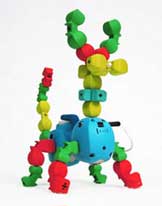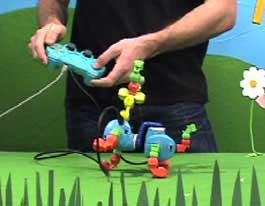Remember Topobo? This 3D construction kit with kinetic memory, developed by Amanda Parkes and Hayes Raffle, allows to build little robots and record + playback their physical motions. By combining Passive (static) and Active (motorized) components, people can quickly assemble and animate animals and skeletons. For example, a dog can be constructed and then taught to gesture and walk by twisting its body and legs. The dog will then repeat those movements and walk repeatedly (video).

 Robo Topobo, by Hayes Raffle and Laura Yip, is the latest update of the Topobo project. It features Robo, a controller that children can use to save, replay and adjust playback of up to four Topobo recordings, directing them like robotic puppets in a performance or like organic machines in a competition.
Robo Topobo, by Hayes Raffle and Laura Yip, is the latest update of the Topobo project. It features Robo, a controller that children can use to save, replay and adjust playback of up to four Topobo recordings, directing them like robotic puppets in a performance or like organic machines in a competition.
To use Robo, a child will first build a Topobo creature and physically program it by twisting its body around. He can save the recording by pressing Robo’s “record” button and then pressing one of its four “playbackâ€? buttons to assign the motion to that button. He can also play the motion backwards and use two joysticks on Robo to change the speed and size of the motion.
We are using Topobo to remove many of the restrictions of computers for children. With Robo, we hope to make engineering lessons implicit in a child’s creative process rather than the focus of it, allowing children to explore the emotionally engaging aspects of performance through design and play. Videos on website.
